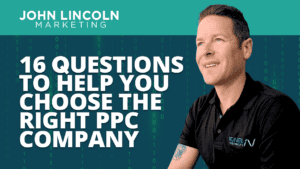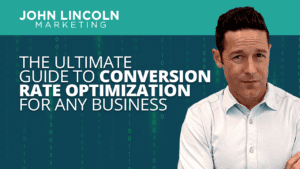
Top 16 Questions to Ask a PPC Company in 2024
In 2024, choosing the right PPC company is not just about spending your advertising budget. You want to make every cent count towards your business

And, believe me, I know how tough it is to keep up.
Unfortunately, all the changes over time have caused confusion among our friends in digital marketing. And, as a result, some of them are now believing things about SEO that simply aren’t true.
I’m here to debunk those SEO myths.
It’s true that not all press releases help your rankings. But that’s true because some press releases are, quite frankly, boring.
If you put out an exciting press release that goes viral, you’ll likely gain visitors from people sharing it on social media.
But beyond that, other websites might link to your PR as well. And since your PR links back to your website, you can pick up new traffic that way as well.
Best of all: you might create a media buzz. That’s definitely going to get more people to your website.
I don’t know how this one got started.
But however it happened, it’s flat-out false. You can’t refresh a web page too many times.
By the way, if you’re unsure about what refreshing a web page even means, it’s the process of editing your old web pages and adding more up-to-date content.
After all, even some of the best info goes “stale” after a while.
Every time you refresh a page, you add more content to it. Then Googlebot crawls that page and sees the new content.
And that new content gets indexed.
Even better: Google might end up ranking that page higher in the search engine results.
Also, you’ll find that some of the biggest websites that rank the highest for keywords earned that rank for two reasons:
So do yourself a favor: keep on refreshing your pages.
Google ranks based on quality, not quantity.
So if the 3,000-word article has more valuable content than the 10,000-word article, Google will likely push that one to the top of the results list.
In fact, I’ve noticed that there seems to be an area in the 3,000-5,000 word count range where you’ve maxed out the long form content threshold.
Everything after that is basically gravy. And search engines don’t go crazy about it.
But I definitely recommend writing long form content whenever possible. Studies in the past have shown that Google will favor articles that run into the thousands in word count.
Okay, that’s more of a question than a myth. But I’m happy to answer it.
And that answer is: sometimes.
Yes, sometimes Google does read content delivered by UI frameworks like Angular and React.
In the past, Google said that its search engine simply doesn’t read content delivered by JS. But that’s clearly not accurate because I can find some of it in the search engine results.
So it’s getting indexed. Sometimes.
But be sure to read the next point.
If you’re thinking about setting up a new website where SEO is important, then I would absolutely encourage you not to go with one of those UI frameworks such as Angular or React. Pick a solution that renders HTML.
WordPress has always been a good option.
It does.
When you run a lot of paid traffic, it grows the size of your brand and increases the number of people who are aware of your product.
And when that happens, people will start searching more and more for your company online. Hopefully, by then you’ve optimized your website for your brand name,
We’ve seen with our clients that paid advertising does indeed lead to more Google searches and external links.
So feel free to keep running with those paid ads. You’ll get organic benefits as well.
Nope.
You might think that you can get to the first page of the search results by cramming “boyfriend jeans” into as many sentences as possible. But that’s not how it works.
Not anymore, anyway.
And that’s why it’s understandable that people believe this myth. Way back in the ancient days of SEO, you probably could get a decent rank with keyword stuffing.
Google’s algorithm has improved quite a bit since then.
But make sure you include your keywords somewhere in your content. Just don’t go overboard with it.
Google might even penalize you for trying that.
Wouldn’t that be nice?
But alas, it wasn’t meant to be.
SEO is a never-ending quest. It’s like the old arcade video game that never stops no matter how well you do.
That’s why you need to learn continually. Grow. And optimize.
Pay attention to the latest digital marketing blogs. Go and practice what they’re preaching.
And never think you’re “done” with SEO. You’re never done.
You’ve probably seen some ads around cyberspace for tools that help you find long-tail keywords. And maybe you’ve been tempted to pull the trigger.
There’s certainly nothing wrong with trying to rank for long-tail keywords. But I don’t want you to think it’s going to be a walk in the park.
By the way, if you’re unfamiliar with the concept of long-tail keywords, they are search terms with four or more words.
A lot of marketers think they’re easy to rank because not too many other folks are optimizing for them.
But sometimes, other folks are optimizing for them. And that makes them more competitive. Even if they’re long-tail keywords.
So keep in mind: it’s keyword competitiveness that matters, not the number of words in the search term.
It’s nice to be at the top, isn’t it?
And sure, who doesn’t want to rank #1 for every relevant keyword?
But it’s not realistic to expect that you’ll get those kinds of results even with the best SEO. You’ll have to settle for some first-page, second through tenth-place rankings.
You may even have to settle for second and third-page rankings for some keywords.
It’s okay. People might not find what they’re looking for on the pages in front of you. Then they’ll hit your site and be happy with your awesome content.
So don’t get stressed out. Just keep working on your SEO to improve your rank.
Welcome to John Lincoln’s personal website. You can learn about John Lincoln’s books, films, book him to speak and contact him. John is directly associated with many of the businesses mentioned on this website and freely discloses this information.

John Lincoln is CEO of Ignite Visibility, one of the top digital marketing agencies in the nation. Ignite Visibility is a 6x Inc. 5,000 company. Ignite Visibility offers a unique digital marketing program tied directly to ROI with a focus on using SEO, social media, paid media, CRO, email and PR to achieve results. Outside of Ignite Visibility, Lincoln is a frequent speaker and author of the books Advolution, Digital Influencer and The Forecaster Method. Lincoln is consistently named one of the top digital marketers in the industry and was the recipient of the coveted Search Engine Land “Search Marketer of The Year” award. Lincoln has taught digital marketing and Web Analytics at the University of California San Diego since 2010, has been named as one of San Diego’s most admired CEO’s and a top business leader under 40. Lincoln has also made “SEO: The Movie” and “Social Media Marketing: The Movie.” His business mission is to help others through digital marketing.
Want to get in touch with John Lincoln? Click Here To Reach Out.

In 2024, choosing the right PPC company is not just about spending your advertising budget. You want to make every cent count towards your business

Whether you’re a seasoned marketer or just starting out, conversion rate optimization (CRO) is a powerful tool that can boost your sales, leads, and overall

Feeling overwhelmed by the sea of SEO companies out there? You’re not alone! Choosing the right partner is crucial for achieving your online marketing
 Franchise Digital Marketing: How to Set up a Successful Strategy
Franchise Digital Marketing: How to Set up a Successful Strategy Over the last 15 years, I’ve worked with hundreds of franchisees. I’ve also worked with corporations that facilitate great franchise